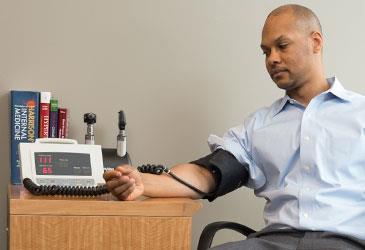Studies show that self-measured blood pressure readings can offer a better picture of a patient’s true blood pressure than measurements taken in a clinical setting, especially if a patient suffers from “white coat hypertension.” Now that you have everything you need to know about self-measured blood pressure monitoring, learn how to start a home monitoring program for your patients.
Here are four things you need to do to implement such a program:
Ensure clinical competency
Blood pressure measurement is a routine task in most practices, but it’s easy to get skewed results if clinicians and patients aren’t on the same page about how to take accurate blood pressure measurements. Clinical staff should be trained and tested on measuring blood pressure accurately to make sure they can effectively teach patients how to measure their own blood pressure.
First, make sure your health care team is getting the most accurate readings by using the “M.A.P.” (Measure accurately, Act rapidly, Partner with patients) checklists (log in) for measurement. A new infographic is a quick reference for health professionals and patients to make sure they are avoiding common measurement errors that can result in a misleading reading.
Next, use a new AMA guide (log in) to help your team expertly work with patients to explain what self-measured blood pressure monitoring is and demonstrate how they should take accurate readings at home.
Determine whether you want to provide blood pressure monitors
Patients can buy blood pressure monitors at drug stores. Prices for a typical high-quality device can range from $50 to $150. The AMA guide explains how to check a patient’s home blood pressure monitor for accuracy and ensure it has been approved under a formal validation protocol.
Unfortunately, many public and private health insurance plans don’t cover the cost of self-monitoring devices. Some physicians choose to purchase monitors and loan them out to patients. The AMA guide includes a checklist to ensure continuity and consistency among staff members when distributing a loaner blood pressure device to patients and a sample device loaner agreement. It also includes a recommended infection prevention process for loaner devices.
Follow criteria for selecting patients to participate
Patients whose blood pressure is measured as greater than 140/90 mm Hg on the first and subsequent readings during an office visit should be screened for the following criteria before becoming part of a home monitoring program:
- Elevated readings persist for two or more subsequent office visits.
- The patient has a diagnosis of hypertension, is being ruled out for a diagnosis of hypertension or has white coat hypertension.
- Your practice’s device has a cuff size appropriate for the patient. (If it doesn’t, the measurement could be skewed.)
- The patient has the aptitude to take an accurate measurement and willingness to take measurements consistently.
- The patient is capable of documenting the readings if the device doesn’t have memory storage capability.
Set up procedures to document and manage the process
To be most effective, self-measured home blood pressures readings should be communicated back to the physician’s office for interpretation. This can happen via phone, fax, patient portal or other ways, as outlined in the guide.
As part of the program, your practice should inform patients how and when you will respond to patient communications and what the patient should do if a measurement is concerning. The average home measurement should be documented in the patient’s health record.
Additional resources
Use the AMA guide to begin engaging your patients in their self-measurement. This resource has fact sheets, patient handouts and adaptable practice tools to help your practice establish and maintain a program for your patients. You also can use additional resources, including:
- Evidence-based checklists to improve blood pressure control (log in)
- Poster to demonstrate proper patient positioning when taking blood pressure
Through its Improving Health Outcomes initiative, the AMA and participating physicians and care teams are working with researchers at the Johns Hopkins Armstrong Institute for Patient Safety and Quality and the Johns Hopkins Center to Eliminate Cardiovascular Health Disparities to develop and test evidence-based blood pressure recommendations and provide practical tools for physician practices.




